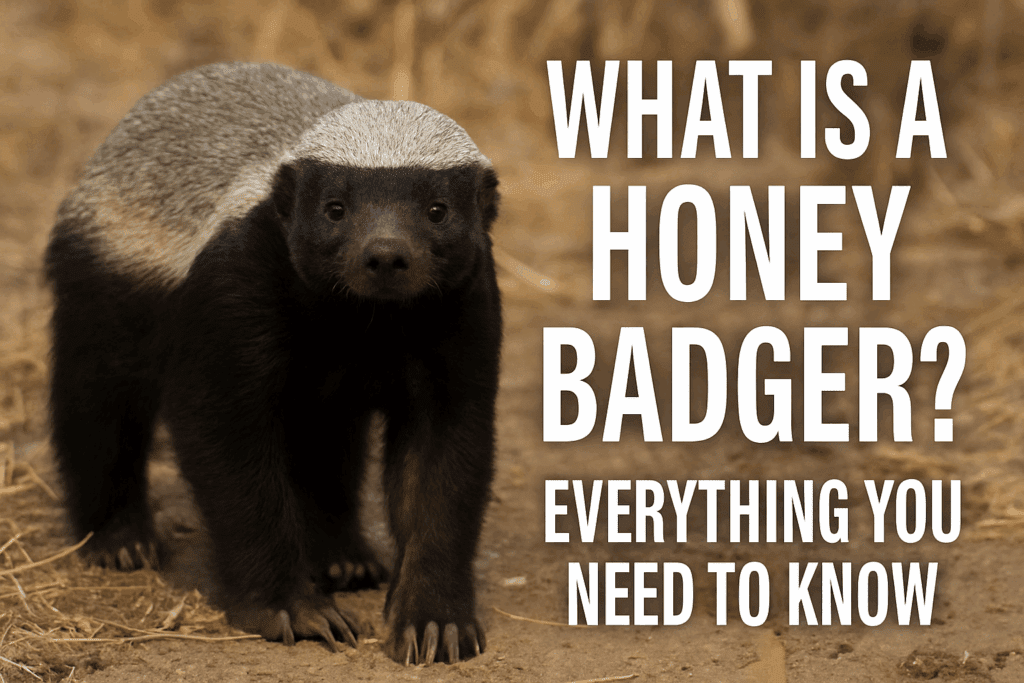Honey badger is one of the most fearless animals in the wild, known for its bold attitude and tough survival skills. Despite its small size, it can take on venomous snakes, fierce predators, and harsh environments without hesitation.
Table of Contents
Introduction
Few animals inspire the mix of admiration, curiosity, and respect quite like the Honey Badger. Known scientifically for its remarkable toughness, this small carnivore has earned an outsized reputation as nature’s most fearless creature.
From sub-Saharan Africa to parts of Asia, the Honey Badger thrives in landscapes that challenge even the hardiest of animals. But it’s not only the Honey Badger’s legendary tenacity that sets it apart it also boasts an impressive array of survival strategies, a voracious diet, and an unexpected level of intelligence.
In this article, we’ll explore everything you need to know about the Honey Badger: how it lives, what it eats, how it defends itself, and why it has captivated scientists and wildlife enthusiasts alike.
Scientific Classification and Name
The Honey Badger’s scientific name is Mellivora capensis. This Latin designation reflects both its fondness for honey (mellivora means “honey eater”) and the region of the Cape (capensis) where it was first documented in southern Africa.
Here is the Honey Badger’s full taxonomic classification:
- Kingdom: Animalia
- Phylum: Chordata
- Class: Mammalia
- Order: Carnivora
- Family: Mustelidae
- Genus: Mellivora
- Species: M. capensis
The Mustelidae family includes otters, weasels, ferrets, and wolverines. Among them, the Honey Badger is especially distinctive for its combination of physical toughness and behavioral audacity.
Interestingly, while sometimes called a “badger,” it is not closely related to European or American badgers. Its lineage is unique within Mustelidae and is considered evolutionarily ancient. Genetic studies have shown that the Honey Badger diverged early from other mustelids, preserving many primitive traits that help explain its exceptional resilience.
Where Do Honey Badgers Live?
Honey Badgers live across a remarkably wide geographic range, stretching from southern Morocco and South Africa all the way to India and Nepal. They occupy more territory than almost any other mustelid, adapting to a stunning variety of habitats.
You can find Honey Badgers living in:
- Dry savannas and grasslands
- Rocky hillsides and scrub forests
- Tropical and subtropical rainforests
- Semi-deserts and arid plains
Unlike many specialized carnivores, the Honey Badger is highly adaptable to different climates and elevations. It can thrive from near sea level to elevations over 2,500 meters in the Ethiopian Highlands.
One fascinating aspect of their habitat preference is their reliance on underground burrows. They often dig their own dens or take over abandoned aardvark tunnels. These burrows serve as safe retreats from extreme temperatures and larger predators.
In India, Honey Badgers have been recorded inhabiting agricultural zones where sugarcane and millet fields attract rodents—an important food source. In Africa, they range across protected reserves and unprotected farmlands alike, demonstrating their flexibility.
Researchers have noted that Honey Badgers can travel vast distances in search of food, sometimes covering more than 20 kilometers in a single night. This nomadic tendency helps explain how Honey Badgers live in such diverse regions.
Physical Features and Appearance
The Honey Badger is instantly recognizable thanks to its striking coloration and sturdy build. Adult Honey Badgers measure about 60–77 centimeters (24–30 inches) in body length, with a tail adding another 20–30 centimeters. They typically weigh between 9 and 16 kilograms (20–35 pounds), though individuals in Asia sometimes grow larger.
Their most distinctive physical features include:
- Two-tone coloration: A broad, pale grey or white “cape” stretches from the top of the head all the way to the tail base, sharply contrasting with jet-black underparts. This bold pattern may serve as a warning to potential predators.
- Stocky, muscular body: Honey Badgers have thick necks and shoulders, a low-slung frame, and short, powerful legs.
- Massive claws: The long foreclaws (up to 4 centimeters) are perfectly adapted for digging into burrows, ripping apart logs, and breaking into beehives.
- Loose, tough skin: One of their most remarkable traits is skin so thick and rubbery it can withstand bites, bee stings, and even machete blows. Because the skin is loose over the body, a Honey Badger can twist inside its own hide to bite back when seized by a predator.
- Small, fierce eyes and strong jaws: Though their eyesight is moderate, their sense of smell is excellent, and their jaws can crack the shells of tortoises.
This rugged anatomy has earned the Honey Badger a reputation as nearly indestructible. According to the BBC’s Natural World documentary “Honey Badgers: Masters of Mayhem,” their skin has been measured up to 6 millimeters thick several times tougher than that of a domestic dog.
Diet: What Do Honey Badgers Eat?
The Honey Badger is one of the most opportunistic feeders in the animal kingdom. While many carnivores specialize in particular prey, Honey Badgers eat almost anything they can overpower or scavenge.
Their diet includes:
- Small mammals: Rodents, ground squirrels, mongooses, and hares
- Reptiles: Lizards, snakes (including highly venomous species like puff adders and cobras), and tortoises
- Birds: Eggs, chicks, and sometimes adult ground-nesting birds
- Invertebrates: Insects, scorpions, and spiders
- Plant matter: Wild fruits, roots, and tubers when meat is scarce
- Honey and larvae: True to their name, Honey Badgers are notorious for raiding beehives. They tolerate hundreds of stings to dig out honeycombs and bee brood
One of the most fascinating examples of their fearless diet is their ability to prey on venomous snakes. According to a study published in Toxicon, Honey Badgers have partial resistance to snake venom. After being bitten, they sometimes become temporarily immobilized but recover within hours and resume feeding on the snake that bit them.
Their taste for honey has even led to a unique partnership with the Greater Honeyguide bird in Africa. The bird will call and guide the Honey Badger to a hidden beehive, and after the Honey Badger breaks it open, the bird feeds on the leftover wax and larvae.
Honey Badgers are so resourceful that they have been seen using their claws to pry open tortoise shells—a feat few predators can accomplish. This varied, bold diet is a key reason Honey Badgers survive in harsh environments where food is unpredictable.
Behavior and Personality Traits
If you had to sum up the Honey Badger’s personality in one word, it would be fearless. This animal’s behavior is the stuff of wildlife legend, often described as astonishingly bold and relentless.
Here are some defining traits of Honey Badger behavior:
- Solitary lifestyle: Honey Badgers are mostly solitary, except during mating or when a mother raises her cub. Each individual ranges widely over a territory that can exceed 500 square kilometers.
- Nocturnal habits: In hotter climates, they primarily hunt at night to avoid daytime heat. However, in cooler regions or seasons, Honey Badgers may become diurnal.
- Incredible persistence: Researchers have documented Honey Badgers working tirelessly for hours to break into burrows or dismantle beehives. Their determination is a key part of their hunting success.
- Remarkable intelligence: In captivity, Honey Badgers have been observed using tools and solving complex puzzles to escape enclosures. The famous case of Stoffel, a Honey Badger in South Africa’s Moholoholo Wildlife Rehabilitation Centre, involved him stacking logs, rolling rocks, and even opening latches to break free demonstrating advanced problem-solving skills.
- Aggressive defense: When threatened, Honey Badgers will growl, hiss, and charge attackers. They have been recorded chasing away much larger predators, including lions and hyenas.
- Scent marking and communication: They use anal gland secretions to mark territory and send warnings. These secretions produce a strong, musky odor that deters intruders.
Despite their intimidating reputation, Honey Badgers are not indiscriminately aggressive. Much of their legendary ferocity is defensive an evolutionary response to living among Africa’s most dangerous predators.
Survival Skills and Defense Mechanisms
Honey Badgers are master survivalists, equipped with an extraordinary toolkit of defense strategies that help them endure threats few animals dare to face.
Here are some of their most impressive survival skills and adaptations:
- Thick, loose skin: One of their primary defenses is their impenetrable hide. When grabbed, a Honey Badger can wriggle inside its own skin to twist around and bite its attacker. This adaptation makes it nearly impossible for predators to subdue them by gripping the neck or back.
- Resistance to venom: Honey Badgers are among the rare mammals partially resistant to snake venom. When bitten by deadly snakes like cobras, they often collapse into a stupor but recover in a few hours then finish eating the snake. This immunity has been studied for insights into antivenom research.
- Ferocious counterattack: If threatened, a Honey Badger doesn’t flee it launches a violent counteroffensive. They have been known to attack the faces and genital areas of much larger enemies to drive them off.
- Powerful digging abilities: With massive claws and powerful forelimbs, Honey Badgers can dig themselves into the ground in minutes. This makes them exceptionally hard to corner.
- Noxious anal secretions: When all else fails, Honey Badgers can release a foul-smelling secretion from their anal glands, similar to a skunk. This musk deters predators and masks their own scent while hunting.
- Relentless endurance: They have an extraordinary pain tolerance and will keep fighting even when injured. Wildlife researchers have reported Honey Badgers continuing to forage despite wounds that would incapacitate most animals.
Their combination of brute strength, fearlessness, and unique biological defenses makes the Honey Badger one of the animal kingdom’s most formidable survivors.
Reproduction and Family Life
Honey Badgers lead largely solitary lives, but reproduction brings brief and important periods of social interaction. Unlike some mustelids with defined breeding seasons, Honey Badgers can breed year-round, though births often peak after the rainy season when food is plentiful.
Here are some highlights of their reproductive and family behaviors:
- Courtship and mating: When a female is in estrus, males pick up her scent trail and follow her over long distances. Courtship can involve extended pursuits, vocalizations, and mutual scent marking.
- Gestation: The gestation period typically lasts 6–8 weeks.
- Birth and development: Females give birth to 1–2 cubs in a secure underground den. Cubs are born blind, hairless, and weighing just a few hundred grams. They remain hidden in the den for the first few months of life.
- Maternal care: The mother is highly protective and will move her cubs to new burrows frequently to avoid predators and parasites. Young Honey Badgers rely completely on their mother’s milk for about 3 months and begin eating solid food by 5–6 months.
- Learning survival skills: Cubs stay with their mother up to 14 months, an unusually long time for a mustelid. During this period, they learn to hunt, dig, and defend themselves. Observers have documented mothers teaching cubs how to raid beehives and kill snakes skills essential for survival.
- Maturity: Honey Badgers reach sexual maturity between 2–3 years of age.
This long and intensive rearing period helps explain why Honey Badgers are so competent and independent as adults. Few animals get such thorough training in self-sufficiency before setting out on their own.
Honey Badgers in Popular Culture
The Honey Badger’s daring personality has captured imaginations worldwide, transforming it into a cultural icon that symbolizes toughness, fearlessness, and determination.
Here are a few notable examples of how Honey Badgers have appeared in popular culture:
- Internet fame: The 2011 viral video “The Crazy Nastyass Honey Badger” narrated by Randall became an internet sensation, amassing over 100 million views. Its memorable line“Honey Badger don’t care!” cemented the animal’s reputation as an unstoppable force of nature.
- Sports nicknames: Several athletes have adopted “Honey Badger” as a moniker. Most famously, NFL star Tyrann Mathieu was nicknamed “The Honey Badger” for his relentless playing style at LSU.
- Wildlife documentaries: Programs such as BBC’s Natural World episode “Honey Badgers: Masters of Mayhem” and National Geographic specials have showcased their intelligence and combat prowess, further elevating their legend.
- Symbol of resilience: In motivational speeches and business circles, the Honey Badger is often cited as a model of persistence. Its image is used on posters and merchandise to inspire grit and determination.
- Children’s books and cartoons: The Honey Badger occasionally appears as a clever or mischievous character in children’s stories, sometimes portrayed as the fearless underdog outsmarting larger animals.
This remarkable animal’s rise from relative obscurity to pop-culture stardom is a testament to how compelling real-world wildlife stories can be. Unlike mythical creatures, the Honey Badger’s feats are very real making its reputation all the more fascinating.
Conservation Status and Threats
Despite their reputation as invincible, Honey Badgers face several real-world threats that have caused concern among conservationists.
Conservation Status:
The International Union for Conservation of Nature (IUCN) currently lists the Honey Badger as Least Concern due to its broad distribution and adaptable nature. However, regional declines have been documented in parts of their range, especially where human conflict intensifies.
Key Threats:
- Human-wildlife conflict: In agricultural areas, Honey Badgers are often persecuted for raiding poultry farms or beehives. In some regions, farmers set traps or use poisoned baits to eliminate them.
- Habitat loss: Expansion of farmland, urban development, and deforestation reduce suitable habitat and disrupt natural food sources.
- Persecution for pelts: While not as heavily targeted as big cats or elephants, Honey Badgers are occasionally hunted for their tough skins, which are used in traditional crafts or as trophies.
- Bycatch and snares: They can become unintended victims of traps set for other wildlife, leading to injury or death.
Protection Measures:
Honey Badgers are legally protected in several African countries. In South Africa, for example, regulations prohibit hunting or trapping them without a permit. Conservation programs often focus on educating farmers about non-lethal deterrents such as reinforced chicken coops and protective beehive fencing to reduce conflict.
One innovative project, called the “Honey Badger Friendly” labeling initiative in South Africa, encourages beekeepers to adopt Badger-safe hive practices. Honey produced this way is certified and sold at a premium, benefiting both farmers and wildlife.
Though Honey Badgers are famously tough, their survival ultimately depends on coexistence with humans who share their landscapes.
Conclusion
The Honey Badger is a true marvel of nature small in size but colossal in spirit. From the arid plains of Africa to the forests of India, this remarkable animal has earned its reputation as one of the fiercest and most adaptable creatures alive.
We’ve explored how Honey Badgers live, what they eat, how they defend themselves, and why they inspire admiration across cultures. Their unique combination of intelligence, resilience, and boldness has made them a symbol of fearlessness and determination.
Yet beneath the legends and viral fame, the Honey Badger is also a vulnerable species in some regions, facing threats from habitat loss, conflict with farmers, and accidental trapping. By supporting conservation efforts and promoting peaceful coexistence, we can help ensure that future generations continue to be amazed by this extraordinary animal.
Whether you admire the Honey Badger for its astonishing survival skills or simply enjoy the larger-than-life stories that surround it, there is no doubt that this creature deserves its place among the world’s most fascinating wildlife.





